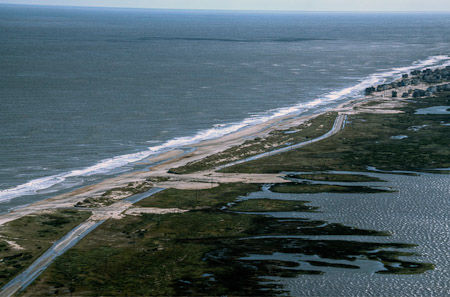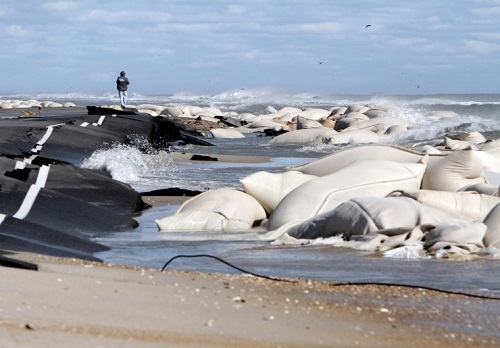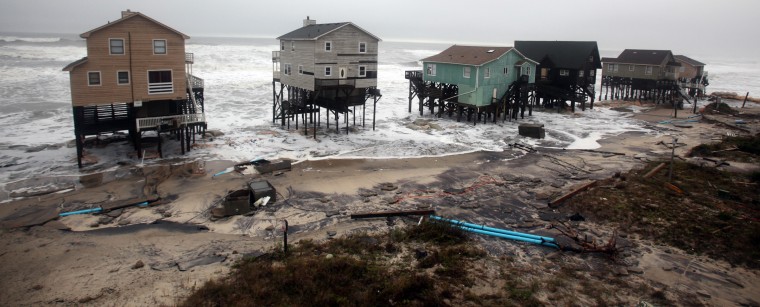August 27, 2013. Just in time for the most active hurricane months, a look at Hurricane Sandy recovery:
Rebuilding. New Jersey will use $250 million in federal Sandy disaster relief funds to buy out as many as 1,000 homes in communities like those along the South River and Raritan Bay that have flooded with increasing frequency. The program aims to buyout entire streets and blocks of buildings in high risk areas. This is not a new use of federal disaster relief funds; similar buyout programs have been used to remove structures from floodplains in other parts of the U.S. after repeated flood events.
The story on the beaches is different. Both New York and New Jersey opted for quick rebuilding in the beach communities. Shoreline changes may have made reconstruction physically impossible on some beach properties, but otherwise the two states decided to allow beach communities to rebuild basically as they were before the storm. The emphasis on quick reconstruction overwhelmed any discussion of policy changes that might lessen damage in future storms. Even with the push to rebuild, residents of N.Y. and N.J. beach communities have experienced delays for all of the usual reasons: the need to cleanup and restore basic public infrastructure; a wait for insurance payouts; the need for additional financing when insurance payouts fell short; the slow realization that some houses still upright after Sandy will have to be bulldozed because of extensive water damage; and the additional cost of elevating homes to meet federal flood insurance standards.
More on new federal flood insurance maps and the cost of elevating structures; beach nourishment projects; and conflicts over reconstruction (and expansion) of seawalls on the New York and New Jersey oceanfront below.
Revised FEMA Flood Maps. The Federal Emergency Management Agency (FEMA) started the 3-5 year process of updating flood insurance rate maps (FIRMs) for eastern seaboard states before Hurricane Sandy. The maps, which designate high hazard flood zones for purposes of the federal flood insurance program, had last been updated in the 1980s. A lot has changed since then; the United States Geological Survey estimates that sea level rise along the New Jersey coast has risen between 6 and 9 inches in the last 50 years and stormwater runoff from increased development also contributes to higher flood risk. FEMA planned to finalize updated flood maps for New Jersey and New York in the second half of 2013, but issued “advisory” maps in December of 2012 to help property owners make rebuilding decisions after Sandy.
As expected, the new FEMA maps had larger flood hazard areas, including larger V-zones; these are areas likely to flood as a result of wave action (“V” stands for velocity) where structures require higher and more expensive elevation. Federal flood insurance standards require structures located in certain high hazard flood zones, such as V-zones and A-zones (the designation for many coastal areas just landward of the V-zones) to be elevated above base flood elevation or pay much higher federal flood insurance premiums. New structures and those more than 50% damaged must be elevated above the new base flood elevation to be insured at all. Elevation can add tens of thousands of dollars in cost; the amount depends on the required height and method used to raise the house.
Shortly before Sandy, Congress amended federal flood insurance laws to make the program more financially stable. The Biggert-Waters Flood Insurance Reform Act of 2012 directed FEMA to make flood insurance rates reflect flood risk and phase out insurance subsidies for homes built before the first federal flood insurance rate maps were adopted in 1975. You can find more information on 2012 changes to the federal flood insurance program here. The prospect of higher flood insurance rates, elevation of additional homes (including homes predating the flood insurance program) and a major east coast hurricane created a perfect storm of confusion and anxiety.
The larger V-zones shown on the advisory maps generated a Stop FEMA Now movement by property owners concerned about the cost of elevating their homes and higher flood insurance rates. New Jersey Gov. Chris Christie urged beach communities to take advantage of the FIRM revision process to provide FEMA with information to support smaller flood hazard zones. By June of 2013, FEMA had modified draft maps for the New Jersey shoreline. Although the June maps still expand flood hazard areas, FEMA reduced the size of many of the V-zones shown on earlier advisory maps. FEMA expects to finalize maps and new flood insurance rates in 2014. In the meantime, the uncertainty about flood hazard designations and elevation requirements caused some homeowners to delay rebuilding.
Note: The 1980’s-era flood insurance rate maps for N.C. have already been updated thanks to a cooperative effort between the state and FEMA. In 1999, North Carolina experienced the problem of out-of-date flood hazard maps when Hurricane Floyd caused devastating and unexpected flooding along coastal rivers and streams. In response, the N.C. General Assembly created and funded the N.C. Floodplain Mapping Program. The new state program took on the technical work needed to update the FIRMs for N.C. under a cooperative agreement with FEMA By 2008, the first phase of map updates (covering the six coastal river basins) had been completed and adopted for use in the federal flood insurance program. As in N.J., more recent N.C. data confirmed the practical experience of Hurricane Floyd — because of sea level rise and increased stormwater runoff, larger areas are vulnerable to significant flooding.
Beach Nourishment. In New Jersey, Hurricane Sandy response means major beach nourishment and dune construction projects to rebuild eroded beaches. Communities that had nourished beaches before Sandy clearly fared better than those that did not. Although Sandy eroded the nourished beaches, the protective dunes took the brunt of the storm rather than the oceanfront development behind the dune line. New Jersey has proposed to rebuild protective dunes that existed before Sandy and extend dune construction to additional communities. The challenges: money, easements and sand (in shorter supply than many people assume).
Money
Dr. Stewart Farrell and colleagues in the Coastal Research Center at Stockton College of New Jersey estimate that between 1985 and 2008 New Jersey beaches received 80 million cubic yards of sand at a cost of $800 million (not adjusted for inflation). The larger beach nourishment projects were built by the U.S. Army Corps of Engineers under a cost-sharing formula with the state. Under the current cost sharing formula, federal funds pay 65% of the cost for an authorized federal “hurricane protection” project to nourish a beach and build protective dunes; the remainder of the cost is shared by state and local government. This year, Congress allocated $5.4 billion to the Corps of Engineers for Hurricane Sandy response. See “The Beach Builders” by John Seabrook in the July 22, 2013 issue of The New Yorker magazine for the past and present of beach nourishment on the New Jersey shoreline.
Not surprisingly, the high cost of beach nourishment periodically causes both Presidents and members of Congress to question the wisdom of investing federal money in projects designed to erode away. Both Presidents Clinton and George W. Bush attempted to either eliminate or scale back federal funding for beach nourishment. Pressure to protect valuable real estate, expensive homes and tourism revenue won out.
Easements
The landward edge of a beach nourishment/dune construction project has to be anchored above the mean high water line — which most often means on private property. For federally funded projects, the U.S. Army Corps of Engineers requires an easement for construction from each private property owner affected and puts the responsibility for acquiring the easements on the local government. Beach towns ( even before Sandy) have sometimes met resistance from property owners for a variety of reasons — most often, fear that the easement will allow public use of their property. New Jersey’s goal is to build continuous lines of protective dunes in Ocean County, Cape May and Atlantic County beach communities. Easement acquisition has been slow; according to a recent local news story only half of the easements needed for the N.J. beach projects have been granted by oceanfront property owners. (Gov. Christie has made his feelings about that known.)
Although a local government can use the power of eminent domain to condemn easements for beach nourishment, an eminent domain case related to an earlier dune construction project in the Borough of Harvey Cedars, N.J. cast a shadow over post-Sandy easement acquisition until very recently. Harvey and Phyllis Karan opposed construction of the 22-foot storm protection dune in Harvey Cedars because it would block the view from the first floor of their oceanfront house. The Karans refused to grant an easement for the project and after the Borough acquired an easement on the Karan property by eminent domain in early 2009, the issue of compensation for the easement ended up in court. The Borough offered the Karans a small amount ($300) to compensate for the impact on their view; the Karans’ lawsuit asked for $500,000, arguing that construction of the dune (which was completed in 2010) reduced the value of their $1.9 million house by 25%.
When the compensation case went to trial, the judge did not allow the jury to consider any benefit to the Karans from construction of the 22-foot dune. The jury awarded the Karans $375,000 in compensation. Hurricane Sandy came through while the Borough’s appeal was pending in the N.J. Supreme Court — eroding the dune, but leaving the Karan home largely undamaged. Hurricane Sandy may well have affected the outcome of the case by so dramatically supporting the Borough’s argument that the dune project benefited the Karan property. In July, the New Jersey Supreme Court issued a decision in Borough of Harvey Cedars v. Karan, 425 N.J. Super. 155 (App. Div. 2012), rev’d and rem’d, ___ N.J. ___ (2013), reversing the condemnation award and sending the case back down for a new trial, saying in part:
“The trial court’s charge required the jury to disregard even quantifiable storm-protection benefits resulting from the public project that increased the fair market value of the Karans’ property… [T]he quantifiable decrease in the value of their property — loss of view — should have been set off by any quantifiable increase in its value — storm-protection benefits. The Karans are entitled to just compensation, a reasonable calculation of any decrease in the fair market value of their property after the taking. They are not entitled to more, and certainly not a windfall at the public’s expense.”
You can find the entire opinion here.
N. J. officials clearly hope that the Karan decision will persuade more oceanfront property owners to grant easements for the shore protection projects rather than hold out for large compensation awards.
Seawalls, Revetments and Groins (Oh my!). Duke University geologist Orrin Pilkey has often used the New Jersey shoreline as the living illustration of the damaging effects of seawalls, revetments and groins on ocean beaches– loss of the recreational beach, obstruction of public access, and increased erosion on nearby properties. Pilkey made “New Jerseyization” the description of a choice to sacrifice the beach to use of engineered structures to protect buildings. (You can find a good introduction to the different types of erosion control structures on the Surfrider Foundation’s Beachapedia website. The Surfrider Foundation has opinions on the subject, but the descriptions and illustrations are straightforward and factual. )
Both New York and New Jersey have permitted construction of oceanfront erosion control structures to protect public and private property. Based on the rules currently in place, New York seems to have fewer restrictions. On paper (sometime practical application looks different), New York coastal policies appear to tilt in favor of permitting an erosion control structure unless it would affect particularly sensitive natural resources such as wetlands. Unlike New Jersey, New York does not require an applicant for a seawall permit to first show that other approaches will not work. New Jersey rules seem to reflect greater skepticism about use of erosion control structures on the ocean beach. In terms of publicly funded beach protection projects, New Jersey has focused on beach nourishment as the preferred public response to post-Sandy shoreline erosion.
Both states have dealt with post-Sandy controversies related to oceanfront seawalls. Before Hurricane Sandy, Ocean City (N.J.) had a seawall made up of boulders 18 feet high. After the hurricane, Ocean City rebuilt and extended the seawall to the boundary with the adjacent town of Matoloking. Matoloking, which lost about 150 feet of beach in Hurricane Sandy, sees the extended seawall as a threat to the beach nourishment and dune construction project in Matoloking –potentially increasing erosion of the protective dunes Matoloking hopes to build.
In Southhampton N.Y., billionaire hedge fund managers built sheet steel and rock barriers oceanward of their homes under permits to replace or repair structures that existed before Hurricane Sandy. Fast track permits issued by the N.Y. Department of Environmental Protection allowed the property owners to build structures larger than those that existed before Sandy, but without notice to neighbors or the local government. A New York Times story described one of the new structures as being built with boulders the size of Volkswagons. Surprised local officials have expressed concern about the impact of these large structures on the beach, as waves reflect off the structures and increase beach erosion.
Although the tide seems to have turned against use of seawalls, groins and revetments on the oceanfront in recent years, past decisions to permit those kinds of structures still echo through the Sandy recovery.



